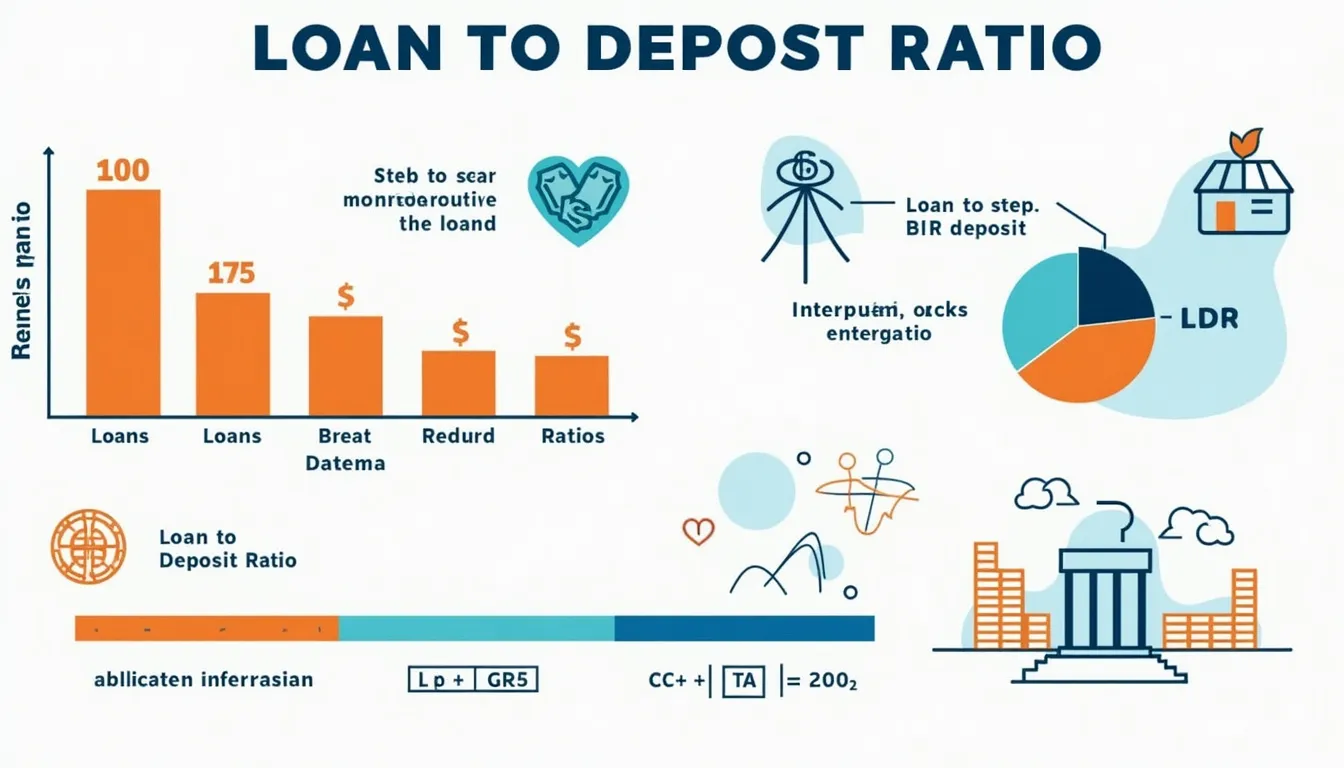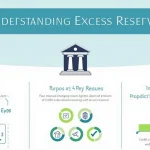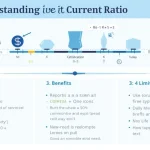Loan to Deposit Ratio Calculator
Is this tool helpful?
How to Use the Loan to Deposit Ratio Calculator Effectively
Our Loan to Deposit Ratio Calculator is a powerful tool designed to help banks, financial institutions, and analysts quickly assess the balance between lending activities and deposit holdings. To use this calculator effectively, follow these simple steps:
- Enter the total amount of loans in the “Total Loans” field.
- Input the total amount of deposits in the “Total Deposits” field.
- Click the “Calculate” button to generate your Loan to Deposit Ratio.
- Review the result displayed in the “Loan to Deposit Ratio” section.
The calculator will automatically compute the ratio by dividing the total loans by total deposits, presenting the result as a decimal number. For example, if your result is 0.85, it means your Loan to Deposit Ratio is 85%.
Understanding the Loan to Deposit Ratio: Definition, Purpose, and Benefits
The Loan to Deposit Ratio (LDR) is a crucial financial metric used by banks and financial institutions to assess their liquidity and overall financial health. This ratio provides valuable insights into a bank’s lending practices and its ability to cover loan losses in the event of economic downturns.
The LDR is calculated using the following formula:
$$ \text{Loan to Deposit Ratio} = \frac{\text{Total Loans}}{\text{Total Deposits}} $$
The purpose of the Loan to Deposit Ratio is to evaluate a bank’s ability to cover loan losses and withdrawals with its deposits. It helps financial institutions maintain a healthy balance between their lending activities and deposit base, ensuring they have sufficient liquidity to meet customer demands and regulatory requirements.
Key Benefits of Monitoring the Loan to Deposit Ratio
- Liquidity Assessment: The LDR provides a quick snapshot of a bank’s liquidity position, indicating how well it can meet short-term obligations and unexpected cash needs.
- Risk Management: By monitoring this ratio, banks can better manage their credit risk and ensure they’re not over-leveraged in their lending activities.
- Regulatory Compliance: Many regulatory bodies use the LDR as a key indicator of a bank’s financial health, making it essential for compliance purposes.
- Performance Benchmarking: The LDR allows for easy comparison between different banks or across different time periods within the same institution.
- Strategic Planning: Understanding the LDR helps in formulating lending and deposit-gathering strategies to maintain optimal balance sheet health.
The Importance of Using a Loan to Deposit Ratio Calculator
Utilizing a Loan to Deposit Ratio Calculator offers numerous advantages for financial professionals, bank managers, and analysts. Here are some key reasons why this tool is invaluable:
1. Accuracy and Efficiency
Manual calculations can be time-consuming and prone to errors, especially when dealing with large numbers. Our calculator ensures quick and accurate results, saving you valuable time and reducing the risk of miscalculations.
2. Real-time Decision Making
With instant results, you can make informed decisions on the spot. Whether you’re in a board meeting or conducting a financial review, having immediate access to this crucial ratio allows for agile decision-making and strategy adjustments.
3. Scenario Planning
The calculator enables you to easily run multiple scenarios by adjusting loan and deposit amounts. This feature is particularly useful for forecasting and strategic planning, allowing you to visualize the impact of different lending or deposit-gathering strategies on your LDR.
4. Consistency in Reporting
By using a standardized calculator, you ensure consistency in how the LDR is calculated across your organization. This uniformity is crucial for accurate internal reporting and external comparisons.
5. Educational Tool
For those new to banking or finance, the calculator serves as an excellent educational tool, helping them understand the relationship between loans and deposits in a practical, hands-on manner.
Addressing User Needs and Solving Specific Problems
Our Loan to Deposit Ratio Calculator addresses several key needs and solves specific problems faced by financial professionals:
1. Regulatory Compliance
Many regulatory bodies require banks to maintain their LDR within specific ranges. Our calculator helps you quickly assess your compliance status and make necessary adjustments to meet regulatory requirements.
2. Liquidity Management
By providing instant LDR calculations, the tool aids in effective liquidity management. It allows you to monitor how changes in your loan portfolio or deposit base affect your overall liquidity position.
3. Risk Assessment
A high LDR might indicate increased credit risk. Our calculator helps you identify potential risk areas quickly, allowing for timely interventions and risk mitigation strategies.
4. Performance Evaluation
The LDR is a key performance indicator for many financial institutions. Our tool facilitates easy tracking and comparison of this metric over time or against industry benchmarks.
5. Strategic Planning
When formulating growth strategies or considering new product offerings, understanding the impact on your LDR is crucial. Our calculator allows you to model different scenarios and their effects on this important ratio.
Practical Applications and Use Cases
To illustrate the practical utility of our Loan to Deposit Ratio Calculator, let’s explore some real-world applications and use cases:
Case Study 1: Community Bank Expansion
A community bank is considering expanding its loan portfolio to boost profitability. Using the calculator, they input their current total loans of $500 million and deposits of $600 million, yielding an LDR of 0.83 or 83%.
They then model a scenario where they increase loans to $550 million without a corresponding increase in deposits. The new LDR would be 0.92 or 92%. This helps them realize that such an expansion might push their LDR too high, potentially increasing liquidity risk. As a result, they decide to implement a deposit growth strategy alongside their loan expansion plans.
Case Study 2: Merger and Acquisition Analysis
A regional bank is considering acquiring a smaller local bank. They use the calculator to assess the impact of the acquisition on their combined LDR. The acquiring bank has $10 billion in loans and $12 billion in deposits (LDR of 0.83), while the target bank has $2 billion in loans and $2.5 billion in deposits (LDR of 0.80).
By inputting the combined figures ($12 billion in loans and $14.5 billion in deposits), they calculate a post-merger LDR of 0.83. This analysis helps them understand that the acquisition won’t significantly alter their overall LDR, supporting their decision to proceed with the merger.
Case Study 3: Regulatory Compliance Check
A national bank operates in a jurisdiction where regulators require banks to maintain an LDR below 90%. The bank’s risk management team uses our calculator monthly to ensure compliance. In their latest check, they input total loans of $75 billion and deposits of $85 billion, resulting in an LDR of 0.88 or 88%.
While still compliant, this ratio is approaching the regulatory limit. The team uses this information to recommend slowing down loan growth or intensifying deposit-gathering efforts to maintain a comfortable buffer below the regulatory threshold.
Case Study 4: Competitive Analysis
A financial analyst is comparing the performance of several banks in a particular market. Using publicly available data and our calculator, they compute the LDR for each bank:
- Bank A: Loans $30 billion, Deposits $35 billion, LDR = 0.86
- Bank B: Loans $25 billion, Deposits $32 billion, LDR = 0.78
- Bank C: Loans $40 billion, Deposits $42 billion, LDR = 0.95
This analysis reveals that Bank C might be taking on more risk with its high LDR, while Bank B appears to have the most conservative lending approach. The analyst uses these insights to inform investment recommendations and further investigate each bank’s strategy and risk profile.
Frequently Asked Questions (FAQ)
Q1: What is considered a good Loan to Deposit Ratio?
A: While there’s no universally “ideal” LDR, many financial experts consider a ratio between 80% and 90% to be healthy. However, the optimal range can vary depending on the economic environment, regulatory requirements, and individual bank strategies.
Q2: How often should I calculate my bank’s Loan to Deposit Ratio?
A: It’s generally recommended to calculate and monitor your LDR on a monthly basis. However, during periods of economic volatility or when implementing significant strategic changes, more frequent calculations may be beneficial.
Q3: What does a high Loan to Deposit Ratio indicate?
A: A high LDR (typically above 100%) suggests that a bank is lending out more money than it has in deposits. This could indicate higher profitability but also increased liquidity risk and potential regulatory concerns.
Q4: Can the Loan to Deposit Ratio be too low?
A: Yes, a very low LDR might indicate that a bank is not efficiently using its deposits to generate income through loans. This could result in lower profitability and potentially signal missed growth opportunities.
Q5: How does the Loan to Deposit Ratio relate to other banking metrics?
A: The LDR is often used in conjunction with other metrics like the Capital Adequacy Ratio, Net Interest Margin, and Liquidity Coverage Ratio to provide a comprehensive view of a bank’s financial health and risk profile.
Q6: Are there any limitations to using the Loan to Deposit Ratio?
A: While the LDR is a valuable metric, it doesn’t provide a complete picture of a bank’s financial health on its own. It should be used alongside other financial ratios and qualitative assessments for a comprehensive analysis.
Q7: How do economic conditions affect the interpretation of the Loan to Deposit Ratio?
A: During economic downturns, a lower LDR might be preferable to maintain higher liquidity. Conversely, in periods of economic growth, a higher LDR might be acceptable as loan demand increases.
Q8: Can I use this calculator for non-banking financial institutions?
A: While the LDR is primarily used in banking, similar concepts can apply to other financial institutions. However, interpretation may vary based on the specific nature of the institution and its regulatory environment.
Q9: How accurate is this Loan to Deposit Ratio Calculator?
A: Our calculator uses a simple and widely accepted formula for computing the LDR. However, it’s important to note that we can’t guarantee that the webtool or results from our webtool are always correct, complete, or reliable. Our content and tools might have mistakes, biases, or inconsistencies.
Conclusion: Harnessing the Power of the Loan to Deposit Ratio Calculator
The Loan to Deposit Ratio Calculator is an indispensable tool for anyone involved in banking, finance, or financial analysis. By providing quick, accurate calculations of this crucial metric, it empowers users to make informed decisions, manage risks effectively, and optimize their financial strategies.
Key benefits of using our Loan to Deposit Ratio Calculator include:
- Instant, accurate calculations for efficient decision-making
- Easy scenario planning and strategy testing
- Improved risk management and regulatory compliance
- Enhanced performance tracking and competitive analysis
- Better understanding of the relationship between lending activities and deposit base
Whether you’re a seasoned banking professional, a financial analyst, or a student of finance, our calculator provides valuable insights into one of the most important metrics in banking. By regularly using this tool and understanding its implications, you can contribute to the financial health and stability of your institution.
We encourage you to bookmark this page and make the Loan to Deposit Ratio Calculator a regular part of your financial toolkit. Start optimizing your bank’s financial health today!
Important Disclaimer
The calculations, results, and content provided by our tools are not guaranteed to be accurate, complete, or reliable. Users are responsible for verifying and interpreting the results. Our content and tools may contain errors, biases, or inconsistencies. We reserve the right to save inputs and outputs from our tools for the purposes of error debugging, bias identification, and performance improvement. External companies providing AI models used in our tools may also save and process data in accordance with their own policies. By using our tools, you consent to this data collection and processing. We reserve the right to limit the usage of our tools based on current usability factors. By using our tools, you acknowledge that you have read, understood, and agreed to this disclaimer. You accept the inherent risks and limitations associated with the use of our tools and services.







